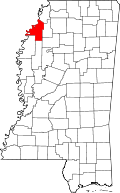2000 Census
As of the census [3] of 2000, there were 1,701 people, 491 households, and 364 families residing in the town. The population density was 4,315.1 inhabitants per square mile (1,666.1/km2). There were 514 housing units at an average density of 1,303.9 units per square mile (503.4 units/km2). The racial makeup of the town was 96.30% African American, 2.59% White, 0.06% Asian, 0.06% Pacific Islander, 0.24% from other races, and 0.76% from two or more races. Hispanic or Latino of any race were 0.47% of the population.
There were 491 households, of which 47.7% had children under the age of 18 living with them, 21.2% were married couples living together, 47.9% had a female householder with no husband present, and 25.7% were non-families. 21.4% of all households were made up of individuals, and 11.0% had someone living alone who was 65 years of age or older. The average household size was 3.46 and the average family size was 4.05.
In the town, the population was spread out, with 44.4% under the age of 18, 11.1% from 18 to 24, 25.0% from 25 to 44, 11.5% from 45 to 64, and 7.9% who were 65 years of age or older. The median age was 21 years. For every 100 females, there were 82.1 males. For every 100 females age 18 and over, there were 65.8 males.
The median income for a household in the town was $17,250 (in 1999 dollars), and the median income for a family was $18,958. Males had a median income of $16,146 versus $19,125 for females. The per capita income for the town was $8,258. About 49.6% of families and 52.1% of the population were below the poverty line, including 57.7% of those under age 18 and 56.3% of those age 65 or over.





